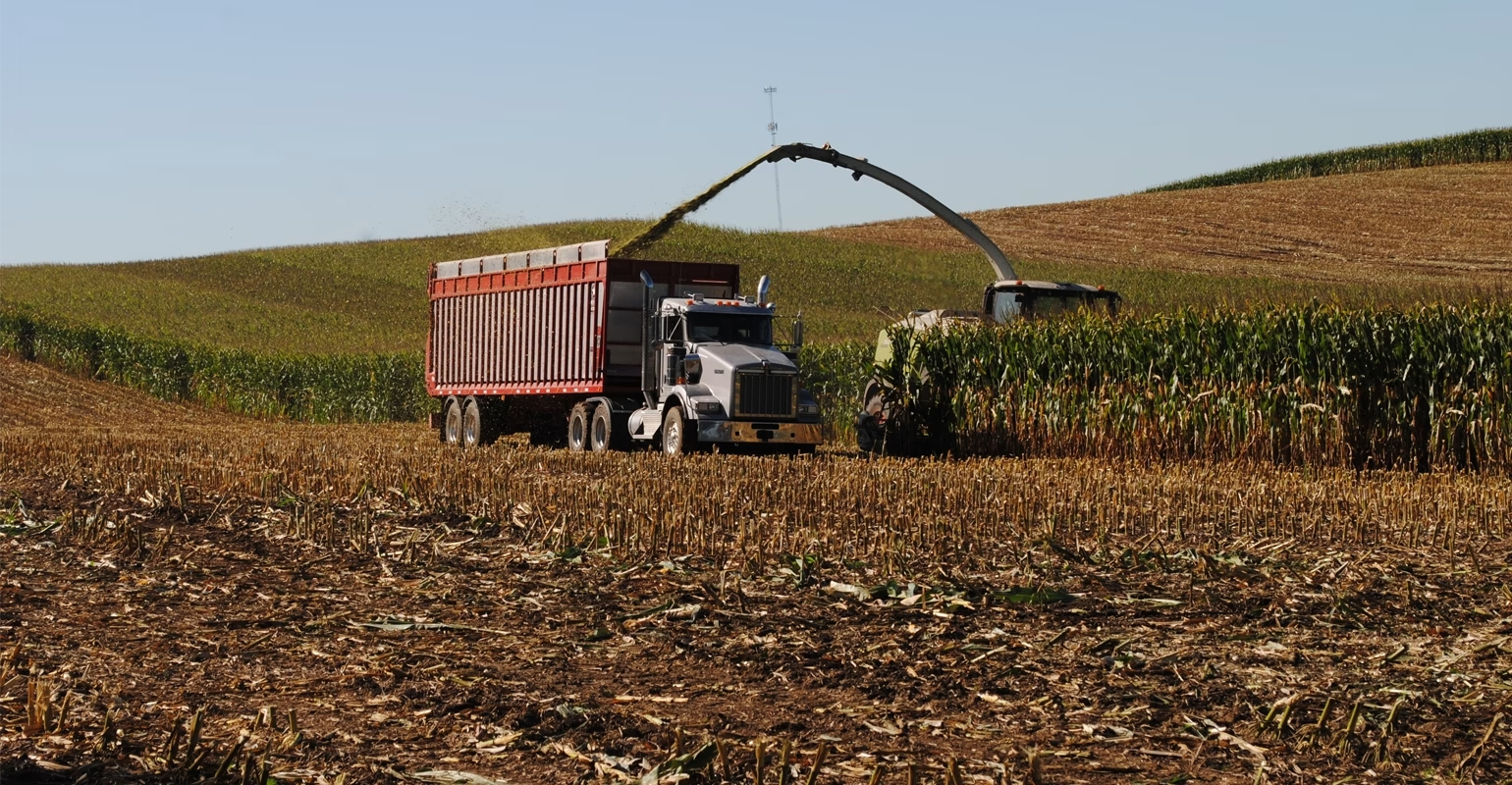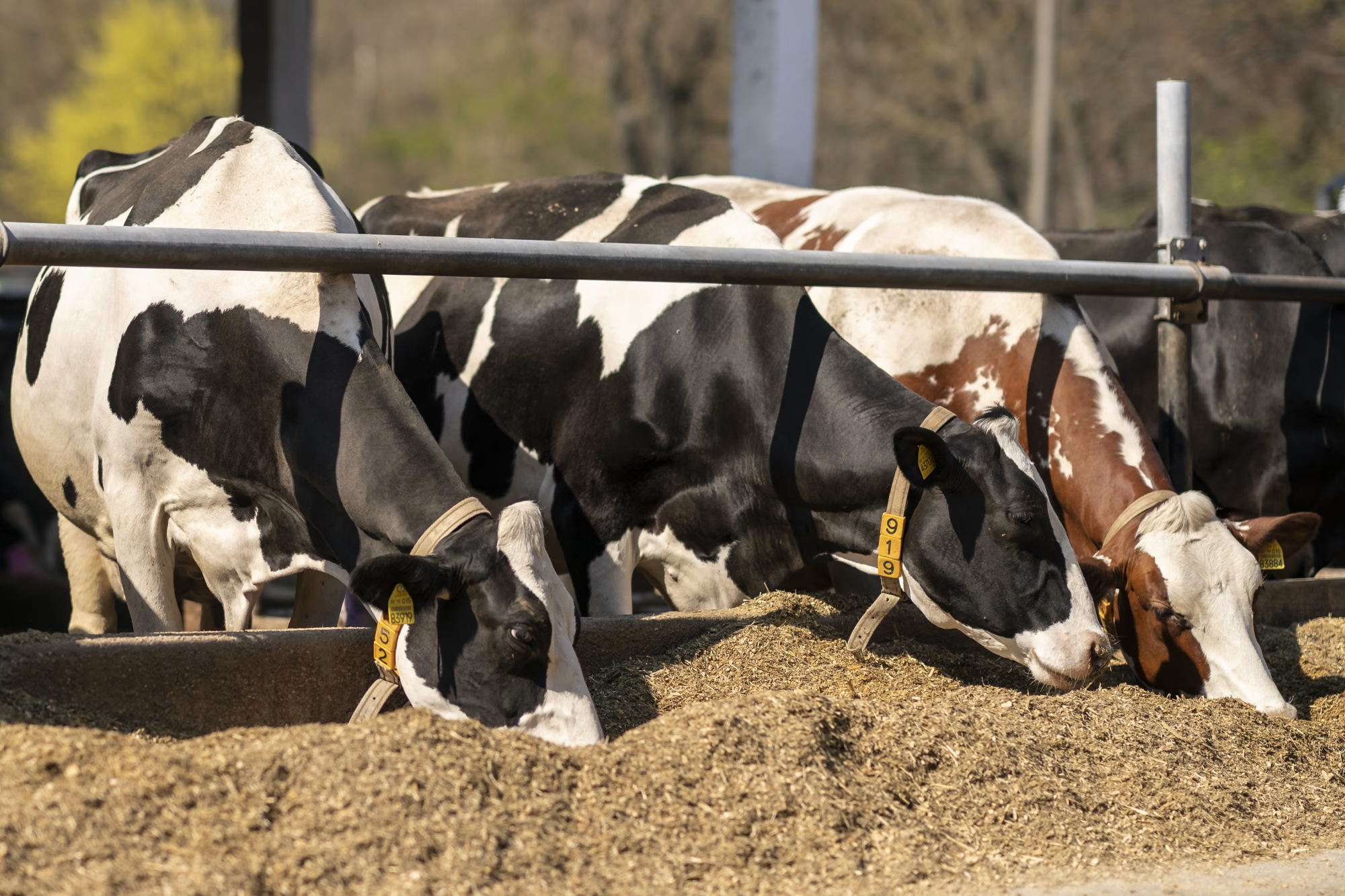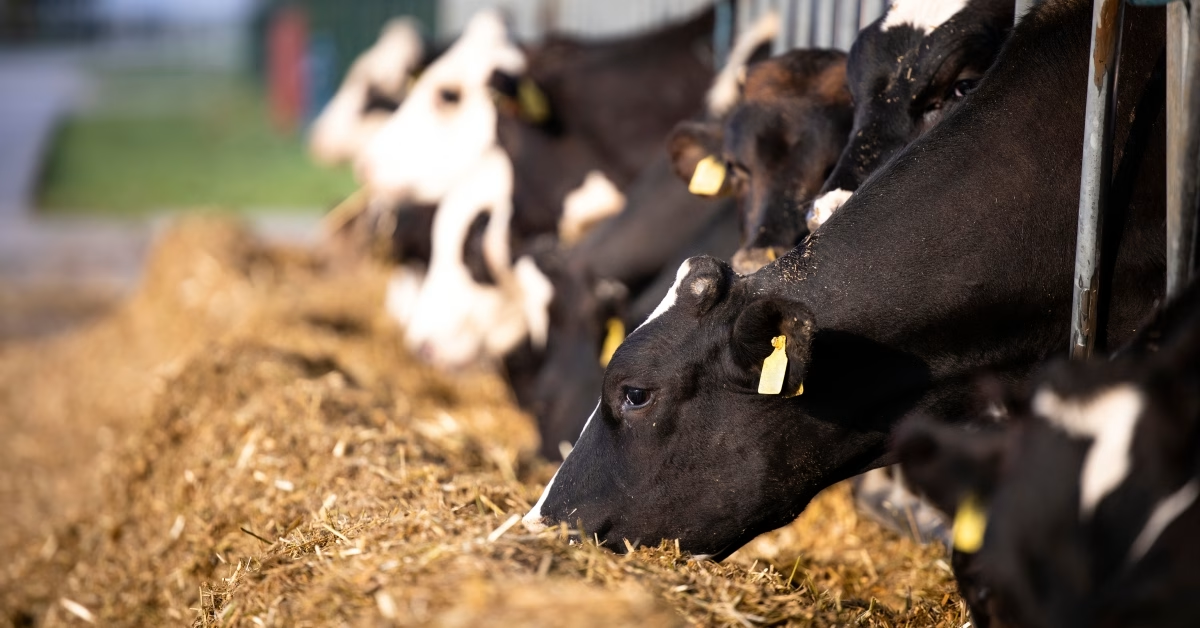Conquer fall forage challenges with expert strategies. Discover ways to enhance feed digestibility and support cow health. Ready to elevate your herd’s productivity?
Summary: Welcome to the challenge of keeping your herd healthy and productive during fall forage transitions. Corn silage harvest season is more than just timing; it’s about dealing with weather, plant maturity, and dry matter unpredictability. As a dairy farmer, you know the ideal: corn at 35% dry matter, fields perfectly dry, and a bunker silo ready to ferment the new crop into digestible gold over six months. But reality brings hurdles like less digestible fresh corn silage, insufficient land, and economic constraints. So, how can you ensure your cows get the nutrients they need amid these challenges? Use probiotics to improve feed digestibility and support the immune system, adopt strategic financial planning to buffer against unexpected conditions, diversify forage options to enhance resilience, and fine-tune feed rations to keep your cows thriving through the fall. Proactive management measures, such as maintaining silage inventory from the previous year and starting probiotic supplementation early, prepare the herd for improved health and production. Consistency is critical to maximizing the long-term benefits of probiotics.
- Ensure timely corn silage harvest by balancing plant maturity and dry matter content.
- Utilize probiotics to enhance feed digestibility and support cow immune systems.
- Implement strategic financial planning to manage economic and environmental challenges.
- Diversify forage options to increase farm resilience and reduce reliance on corn silage alone.
- Fine-tune feed rations for optimal cow health and productivity during fall transitions.
- Maintain the previous year’s silage inventory and start probiotic supplementation early for smoother transitions.
- Consistency in probiotic use is crucial for maximizing long-term herd health benefits.

As the cool autumn air settles, the importance of the corn silage harvest season becomes paramount for dairy producers. This period, filled with opportunities and challenges, plays a crucial role not only in milk production but also in the financial stability of your farm. The autumn foraging season is a key contributor to your farm’s financial health. Despite the unpredictable weather, crop maturity, and fermentation timing challenges, there are strategies to enhance feed digestibility and bolster your herd’s immune system. Are you prepared for this crucial season? Let’s delve into some ways to guide you through this period.
Mastering the Timing: Balancing Plant Maturity and Dry Matter in Corn Silage Harvest
Understanding the timing of the corn silage harvest is not just crucial for maintaining peak feed quality and cow health, but also for maximizing your financial returns. The two main parameters, plant maturity and overall plant dry matter, often don’t align perfectly, making it a challenging and intricate process to predict the ideal harvest time. However, with the right strategies, you can master this timing and reap the financial benefits.
Plant maturity is when the corn plant has completed its full developmental potential, as shown by the production of the corn cob and the hardening of the kernels. Whole plant dry matter, on the other hand, determines the moisture content of the complete plant, from stem to seed. Producers should strive for a dry matter concentration of roughly 35% to enable optimal fodder preservation and milk production efficiency.
However, the situation could be better. Weather patterns may be unpredictable, thwarting even the best-laid preparations. A sudden precipitation may raise moisture levels, delaying harvest. Still, an unexpected dry spell might result in too developed plants with the high dry matter, making them less edible. In many circumstances, these unexpected conditions require farmers to make difficult choices, often settling on the lesser of two evils to save their crops.
The absence of synchronization between plant development and dry matter content is difficult. Farmers often find themselves racing against the clock, attempting to harvest at the optimal time. Understanding these complexities and planning for fluctuation may significantly affect the quality of silage produced, eventually affecting the herd’s health and production.
Reality Check: Bridging the Gap Between Ideal Conditions and Real Challenges
Consider the ideal scenario: you harvest corn at precisely 35% dry matter on a bright, sunny day. Your fields are dry, your equipment operates smoothly, and the silage is flawlessly packed into a bunker silo designed for ideal feed-out conditions. In this perfect case, your silage ferments for six months straight, yielding maximal starch digestibility. What is the payoff? High-quality feed that promotes milk production and overall herd health.
However, we know that reality seldom aligns precisely. Weather patterns are unpredictable, fields may be excessively wet or dry, and mechanical malfunctions might happen at the worst moments. Many of us confront the issue of filling silos with low-quality dry matter corn silage. As a result, silage is not wholly fermented by the time it reaches the feed bunk. So, what is the most realistic route forward?
Management methods and dietary treatments are critical for closing the gap between the ideal and the actual. Incorporating targeted probiotics may increase the digestibility of crop silage, increasing nutritional availability and productivity. This strategy reduces the disadvantages of feeding less digestible silage while promoting consistent herd performance.
Balancing Act: Tackling the Digestibility Drop in Fresh Corn Silage
Many dairy producers may face a significant hurdle while feeding this year’s new crop, corn silage. The new silage is often less digestible than the previous year’s more extensively fermented crop. This decrease in digestibility might result in lower nutritional availability, affecting milk production and overall herd health. It’s a delicate balance to optimize feed quality when dealing with silage that is still fermenting.
One successful technique for addressing these concerns is including targeted probiotics in your feeding plan. These probiotics may improve the digestibility of total tract-neutral detergent fiber (NDF) and starch, allowing your cows to absorb more nutrients. Improved production efficiency leads to increased milk output and components. Research backs up these advantages, proving that improved digestibility translates to more accessible energy for the cow, which is critical during the difficult lactation phase.
The critical point is not just about addressing urgent dietary difficulties; it’s about establishing proactive management measures. These include keeping some silage inventory from the previous year to combine with the fresh crop and beginning probiotic supplementation early. By adopting these proactive efforts, you can reassure yourself that your herd is prepared for improved health and production, even if the feed is less than optimal.
The Power of Probiotics: Unlocking Nutrient Potential and Boosting Dairy Efficiency
Probiotics may significantly improve the digestibility of total tract-neutral detergent fiber (NDF) and starch. Probiotic products enhance rumen fermentation by promoting microbial equilibrium inside the cow’s digestive tract. This leads to a more effective digestion of fiber and carbohydrates, directly translating into improved nutritional absorption.
Introducing targeted probiotics may significantly increase the digestibility of these critical components. According to studies, better digestibility equals more energy accessible to the cow, resulting in higher total production efficiency. For example, cows that are given probiotics produce more milk and milk components. In a controlled trial, dairy cows given a probiotic supplement had a significantly higher fat-corrected milk output and protein yield than the control group (Smith et al., 2020).
Furthermore, the benefits of enhanced digestibility go beyond milk production. Improved nutrient absorption promotes overall cow health, perhaps leading to more extended lactation periods and an enhanced herd lifetime. Probiotics enhance energy and immunological function, producing a more resilient and productive dairy business.
The Hidden Danger: How Poor Fermentation Puts Your Herd at Risk
Improperly fermented corn silage offers serious dangers, including the spread of infections, molds, and toxins. When corn silage does not ferment properly owing to excess moisture or dryness, it fails to establish an environment restricting the hazardous agents. Consequently, your cows may consume feed that affects their health, resulting in lower milk output and overall herd profitability.
So, how do probiotics fit into this picture? Probiotics improve gastrointestinal function by preserving tight junction integrity. Think of these junctions as gatekeepers; when they work correctly, they restrict the ability of hazardous bacteria and poisons to enter the bloodstream and cause havoc. Probiotics encourage robust gut health and help maintain your herd in top shape.
Furthermore, healthy probiotic bacteria release bacteriocins, proteins, or peptides that serve as natural antibiotics. Bacteriocins block dangerous bacteria, reducing infections and health difficulties. This natural defensive response promotes better gut flora, benefiting the cow’s health.
But the advantages don’t end there. Probiotics are also crucial for improving immunological function. A robust immune system enables cows to adapt more effectively to various situations. When confronted with infections, neutrophils—your cow’s first line of defense—secrete antibacterial enzymes and reactive oxygen species to destroy threats. Probiotics support this response, ensuring neutrophils function optimally. Meanwhile, native T-cells develop into specialized cells that generate cytokines, facilitating a coordinated immune response.
Incorporating probiotics into your herd’s diet establishes a strong foundation for health, allowing your cows to flourish even in the face of problems such as inadequately fermented corn silage.
Consistency is Key: Maximizing the Long-term Benefits of Probiotics
Consistency is essential for gaining all of the advantages that probiotics provide. Lactating and dry cows may keep their digestive and immunological systems steady and robust by introducing probiotics regularly throughout the year. This isn’t just about short-term results; the magic occurs with consistent usage.
The study emphasizes that the most significant benefits emerge after three to four weeks of consistent probiotic administration. This interval allows for establishing beneficial bacterial communities in the gut, which improves digestion, nutritional absorption, and immunological function. As we all know, a healthy cow is more productive.
Consider the cumulative influence during the entire breastfeeding period. Continuous usage helps cows adjust to new meals and handle stresses, increasing herd profitability. So, although the initial cost may seem significant, the long-term benefits—increased milk supply, higher component quality, and overall herd health—outweigh it.
Strategic Financial Planning: Cushioning Against the Unpredictable
Regarding autumn forage management, financial preparation is as necessary as collecting and storing. The unpredictability of weather and shifting market prices may cause severe financial distress. However, with a systematic strategy, you may reduce these risks and ensure the economic sustainability of your dairy farm.
Budgeting for Unpredictable Weather and Market Prices
Weather unpredictability may disrupt your harvest plans, reducing fodder quality and increasing prices. To prepare for this, set aside a percentage of your budget as a contingency reserve. This fund should cover possible expenses such as emergency purchases of supplementary feed, more labor for faster harvests, and repairs to weather-damaged equipment.
Market pricing for feed components and milk might fluctuate, influencing your bottom line. Use past data to forecast price patterns and lay up reserves during high milk price periods to protect against low-price cycles. When feasible, use forward contracts to lock in pricing for critical inputs and outputs, helping to stabilize your financial outlook.
Securing Financial Assistance
Investigate opportunities for loans or grants that offer a financial safety net during difficult times. The USDA, for example, offers programs expressly tailored for agricultural producers, such as the Farm Loan Programs, which address a wide range of requirements, from operating expenditures to equipment acquisitions. Grants at the state level may also help to pay the costs of new agricultural techniques or catastrophe recovery.
Consider establishing a line of credit with your financial institution. This provides you with flexible access to finances at essential periods without the lengthy approval procedure of traditional loans. Build a solid connection with your lender; they can offer personalized financial options that fit your farm’s operating cycle.
Finally, keeping detailed and up-to-date records of your farm’s financial status is critical. These documents provide a clear picture of your financial situation and make you a better candidate for loans or grants. Detailed paperwork may speed up the application process and boost your chances of receiving the required money.
By proactively controlling your financial risks via careful preparation and using accessible financial tools, you can quickly negotiate the difficulties of autumn forage management.
Thinking Beyond Corn: Diversifying Forage Options for Resilience
When corn silage isn’t a feasible choice, whether due to inconsistent weather or unanticipated events, it’s critical to have alternate fodder options in place; looking into other crops like sorghum, alfalfa, or small grains may provide solid alternatives for dairy farms.
Sorghum: When drought circumstances make maize production difficult, sorghum might come to the rescue. This crop flourishes in dry, hot areas where corn fails. Sorghum also uses less water and nitrogen, making it an inexpensive alternative. However, due to its reduced calorie content compared to corn silage, ration formulations may need to be adjusted to fulfill your herd’s nutritional requirements.
Alfalfa: Alfalfa is another good fodder choice, known for its high protein content and digestibility. It may help your dairy herd produce more milk and stay healthier. On the negative, alfalfa needs well-managed, rich soils and enough rainfall or irrigation, which may raise management intensity and expenses. Furthermore, picking alfalfa at the proper growing stage is critical to capturing its full nutritional potential.
Small Grains: Crops such as barley, oats, and triticale may fill the void during corn silage shortages. These grains may be sown in the autumn and harvested in the spring, providing a timely feed source to support dairy operations. While they benefit from fitting into double-cropping systems and promoting soil health, they often have lower fiber digestibility and energy levels than corn silage, which may affect milk output and need balancers in the diet.
Incorporating these alternative forages into your approach requires a precise balance of nutritional profiles and an awareness of your farm’s unique environment. Diversifying your forage alternatives may offer a safety net, increasing resistance to unforeseen weather and economic variations. Planning allows you to guarantee that your herd continues to get high-quality feed, regardless of the obstacles that arise.
Fine-Tuning Your Fall Feed Rations: How to Keep Your Cows Thriving
Monitoring and adjusting feed rations during the fall is essential for maintaining optimal cow health and milk production. Here are some actionable tips to help you stay on top of your forage game:
- Regular Forage Testing: Conduct forage analysis regularly, particularly following changes in the forage supply. This will provide you with a nutritious composition, including protein, fiber, and mineral content, necessary for making educated judgments.
- Interpret the Results: Carefully consider the figures for Neutral Detergent Fiber (NDF) and Acid Detergent Fiber (ADF), which reflect the forage’s digestibility. High NDF and ADF levels might limit consumption and milk output.
- Adjust Rations Accordingly: Adjust the grain-to-forage ratio in your Total Mixed Ration (TMR) using the forage analysis. Consider adding a protein supplement if the forage has a low protein level. In contrast, if the starch level is excessive, you may need to limit grain supplements to prevent stomach difficulties.
- Monitor Cow Performance: Track milk output, body condition ratings, and general cow health. Use this information to make additional adjustments to the rations. Suppose you detect a decrease in milk output or changes in cow behavior. In that case, it may be time to reassess your forage analysis and make modifications.
- Consult with a Nutritionist: Regularly consult with a dairy nutritionist to assess forage analysis data and make exact feed modifications. Their experience may assist you in improving feed efficiency and cow health throughout the difficult autumn months.
- Maintain Consistency: Ensure the TMR is mixed uniformly and consistently throughout feedings. Inconsistent feeds might cause cows to sort, which affects nutritional intake and overall performance.
By integrating these practical ideas, you can make real-time modifications to your feeding methods based on concrete forage analysis data, thereby improving cow health and milk output in the autumn.
The Bottom Line
The autumn forage season requires more than just typical practices—mastering timing, using probiotics, and protecting your herd’s health. We’ve looked at the delicate balance between plant maturity and dry matter, the realities of less-than-ideal environments, and strategies for improving feed digestibility. Probiotics are essential for improving nutritional intake and immunological response, and regular feeding regimens provide year-round advantages.
Proactive management and specialized nutritional solutions are not simply suggestions; they are required to address the issues of autumn forage. As the harvest approaches, the question arises: Are you prepared to implement these methods on your farm?
Learn more:
- Understanding Seasonality in the Dairy Production System
- Get Ready. Get Set. It’s Time for a Better Dairy Winter Feeding Program!
- Why 80% of U.S. Dairy Farms Are Struggling: An Insider’s Look at the Unseen Challenges
 Join the Revolution!
Join the Revolution!
Bullvine Daily is your essential e-zine for staying ahead in the dairy industry. With over 30,000 subscribers, we bring you the week’s top news, helping you manage tasks efficiently. Stay informed about milk production, tech adoption, and more, so you can concentrate on your dairy operations.







 Join the Revolution!
Join the Revolution!








